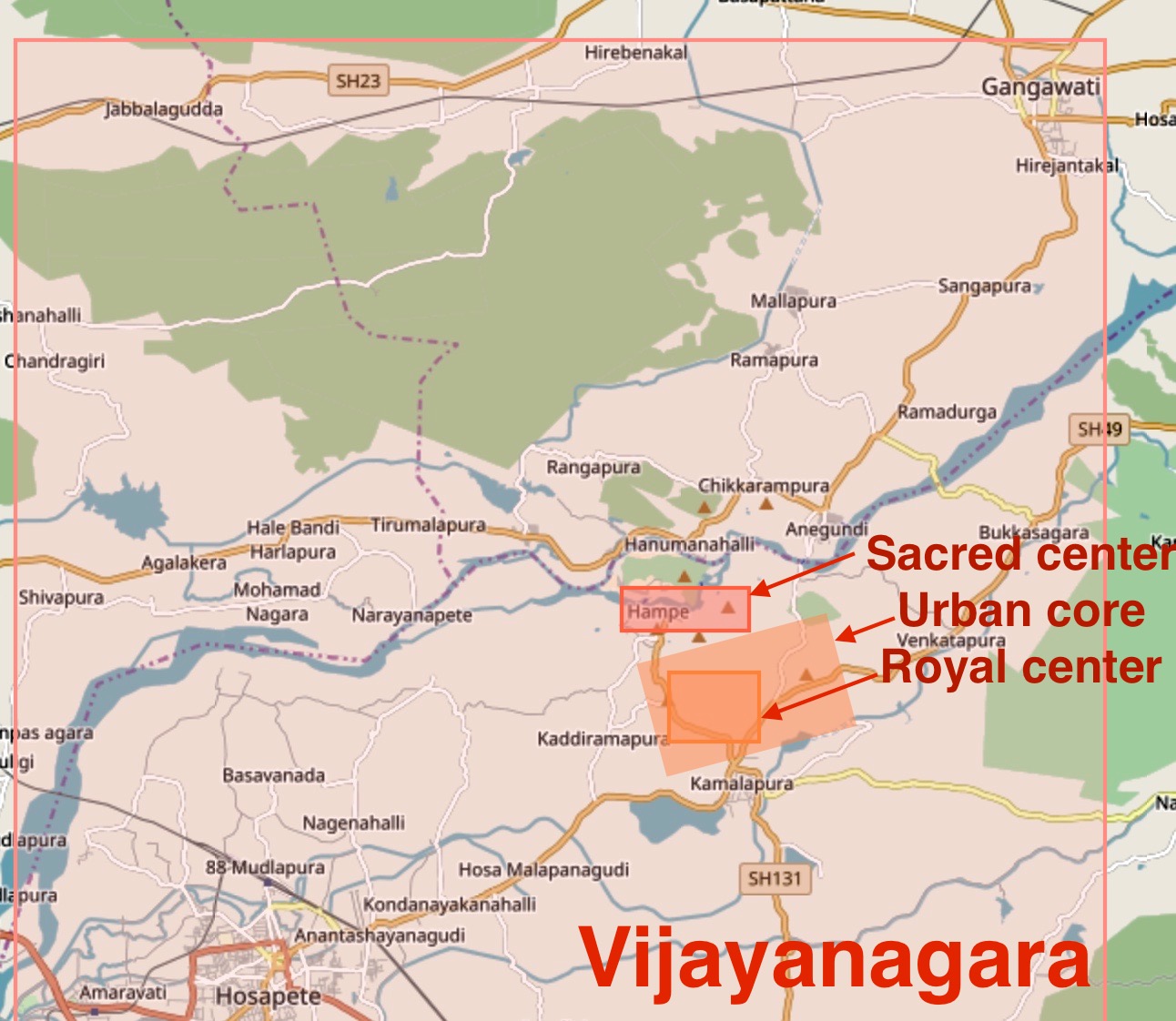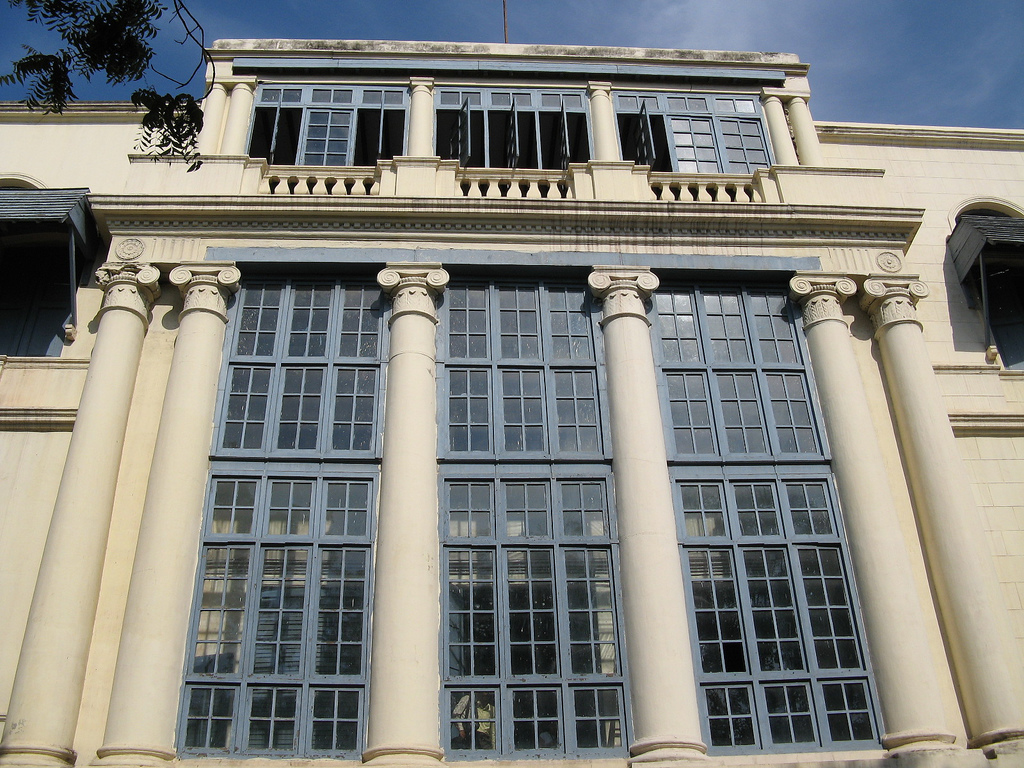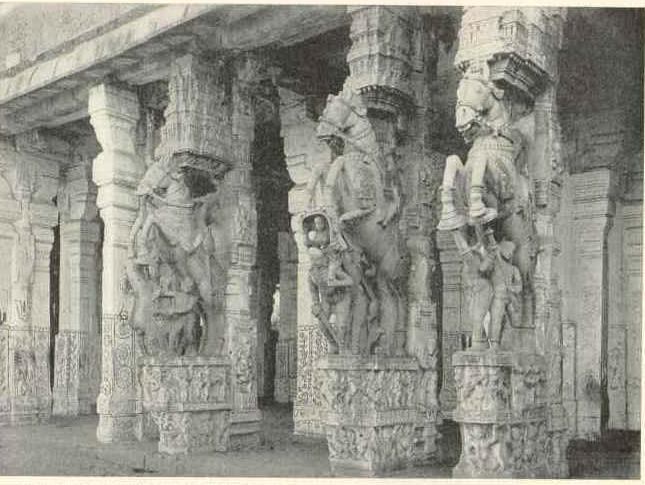|
Kumara Krishnappa Nayak
Kumara Krishnappa Nayak was a ruler of the Madurai Nayak dynasty. He was the successor of King Vishwanatha Nayak. He started ruling the country after his father's death in 1564. He made Tiruchirapalli as his capital. Expansion of the dynasty Under Kumara Krishnappa Nayak's rule, the Madurai Nayak dynasty expanded. Most of the ancient Pandyan territories came under the Nayaks under his rule. In 1565 the Sultan rulers of the Deccan defeated Vijayanagar, the suzerain of the Nayaks, at the battle of Talikota. Vijayanagar had to abandon their capital Vijayanagara and reestablish at Penukonda in Anantapur, then reestablish at Vellore Fort and Chandragiri near Tirupathi, which later granted land to the British East India Company to build a fort at the present day Chennai. Finally they settled at Vellore in North Arcot. Their governors at Madurai, Kalahasti, Gingee and Tanjore Thanjavur (), also Tanjore, Pletcher 2010, p. 195 is a city in the Indian state of Tamil Nadu. Thanjavu ... [...More Info...] [...Related Items...] OR: [Wikipedia] [Google] [Baidu] |
Vishwanatha Nayak
Viswanatha Nayak was the Vijayanagara viceroy to Madurai in south India during the 16th century. He later became the ruler of Madurai after the fall of the Vijayanagara empire. He is the founder of the Nayak dynasty of Madurai.Saints, Goddesses and Kings By Susan Bayly He was supported by his general Ariyanatha Mudaliar who led Viswantha Nayak's army became second in command and took power along with the latter in Tirunelveli in southern India. Viswantha Nayak was then succeeded by his son Krishnappa Nayak who along with his father's able minister Ariyanatha expanded the Madurai Kingdom under the Nayaks and brought most of the ancient Pandyan territory under its rule. History He was the son of Nagama Nayaka, the successful general of Krishnadevaraya in the Vijayanagara empire. In the early 16th century, the Chola ruler Veerasekara Chola invaded the Madurai country and deposed the Pandya king Chandrasekara Pandyan. The Pandya king was under the protection of the Vijayana ... [...More Info...] [...Related Items...] OR: [Wikipedia] [Google] [Baidu] |
Tiruchirapalli
Tiruchirappalli () (Renaming of cities in India, formerly Trichinopoly in English), also called Tiruchi or Trichy, is a major tier II city in the States and union territories of India, Indian state of Tamil Nadu and the administrative headquarters of Tiruchirappalli district. The city is credited with being the best livable city and the cleanest city of Tamil Nadu, as well as the fifth safest city for women in India. It is the fourth largest city as well as the fourth largest urban agglomeration in the state. Located south of Chennai and north of Kanyakumari, Tiruchirappalli sits almost at the geographic centre of Tamil Nadu state. The Cauvery Delta begins west of the city where the Kaveri, Kaveri river splits into two, forming the island of Srirangam which is now incorporated into the Tiruchirappalli City Municipal Corporation. The city occupies an area of and had a population of 916,857 in 2011. Tiruchirappalli's recorded history begins in the 3rd century BC, when it wa ... [...More Info...] [...Related Items...] OR: [Wikipedia] [Google] [Baidu] |
Talikota
Talikoti also Talikot is a taluq in Vijaypur district in the northern part of the Indian state of Karnataka, about 85 kilometres to the southeast of Vijayapura city. It lies on the river called Doni. It is famous for the Battle of Talikoti in 1565. Geography Talikoti is located at . It has an average elevation of 509 metres (1669 feet). Demographics India census, Talikota had a population of 68,217. Males constitute 56% of the population and females 44%. Talikoti has an average literacy rate of 72%, higher than the national average of 59.5%: male literacy is 81%, and female literacy is 62%. In Talikoti, 22% of the population is under 6 years of age. See also *Bijapur *Muddebihal *Basavana Bagewadi *Sindagi *Bagalkot *Karnataka Karnataka (; ISO: , , also known as Karunāḍu) is a state in the southwestern region of India. It was formed on 1 November 1956, with the passage of the States Reorganisation Act. Originally known as Mysore State , it was ... [...More Info...] [...Related Items...] OR: [Wikipedia] [Google] [Baidu] |
Vijayanagara
Vijayanagara () was the capital city of the historic Vijayanagara Empire. Located on the banks of the Tungabhadra River, it spread over a large area and included the modern era Group of Monuments at Hampi site in Vijayanagara district, Bellary district and others in and around these districts in Karnataka, India. A part of Vijayanagara ruins known as Hampi has been designated as a UNESCO world heritage site. Vijayanagara is in the eastern part of central Karnataka, close to the Andhra Pradesh border.Vijayanagara Encyclopaedia Britannica Hampi is an ancient human settlement, mentioned in Hindu texts and has pre-Vijayanagara temples and monuments. In early 14th century, the Deccan region including the dominant |
Vellore Fort
Vellore Fort is a large 16th-century fort situated in heart of the Vellore city, in the state of Tamil Nadu, India built by Vijayanagara kings. The fort was at one time the headquarters of the Aravidu Dynasty of the Vijayanagara Empire. The fort is known for its grand ramparts, wide moat and robust masonry. The fort's ownership passed from Vijayanagara kings, to the Bijapur sultans, to the Marathas, to the Carnatic Nawabs and finally to the British, who held the fort until India gained independence. The Indian government maintains the fort with the Archaeological Department. During British rule, the Tipu Sultan's family and the last king of Sri Lanka, Sri Vikrama Rajasinha were held as prisoners in the fort. It is also a witness to the massacre of the Vijayanagara royal family of Sriranga Raya. The fort houses the Jalakanteswarar Hindu temple, the Christian St. John's Church and a Muslim mosque, of which the Jalakanteswarar Temple is famous for its magnificent carvings. Th ... [...More Info...] [...Related Items...] OR: [Wikipedia] [Google] [Baidu] |
Chandragiri
Chandragiri is a suburb and neighbourhood of Tirupati and located in Tirupati district of the Indian state of Andhra Pradesh. It is a part of Tirupati urban agglomeration and a major growing residential area in Tirupati It is the mandal headquarters of Chandragiri mandal in Tirupati revenue division. It also falls in the jurisdictional limit of Tirupati Urban Development Authority. Chandragiri is the southwestern entrance of Tirupati for vehicles coming from Bangalore, Kerala and Tamil Nadu. Kalyana Venkateswara Temple, Srinivasamangapuram is located next to Chandragiri through which well-laid stone footpaths called srivari mettu are available to reach Tirumala on foot History Chandragiri fort Chandragiri is now famous for the historical fort, built in the 11th century, and the Raja Mahal (Palace) within it. The fort encircles eight ruined temples of Saivite and Vaishnavite pantheons, Raja Mahal, Rani Mahal and other ruined structures. The Raja Mahal Palace is ... [...More Info...] [...Related Items...] OR: [Wikipedia] [Google] [Baidu] |
Chennai
Chennai (, ), formerly known as Madras ( the official name until 1996), is the capital city of Tamil Nadu, the southernmost Indian state. The largest city of the state in area and population, Chennai is located on the Coromandel Coast of the Bay of Bengal. According to the 2011 Indian census, Chennai is the sixth-most populous city in the country and forms the fourth-most populous urban agglomeration. The Greater Chennai Corporation is the civic body responsible for the city; it is the oldest city corporation of India, established in 1688—the second oldest in the world after London. The city of Chennai is coterminous with Chennai district, which together with the adjoining suburbs constitutes the Chennai Metropolitan Area, the 36th-largest urban area in the world by population and one of the largest metropolitan economies of India. The traditional and de facto gateway of South India, Chennai is among the most-visited Indian cities by foreign tourists. It was rank ... [...More Info...] [...Related Items...] OR: [Wikipedia] [Google] [Baidu] |
Vellore
Vellore (English: ), also spelt as Velur (), is a city and the administrative headquarters of Vellore district in the Indian state of Tamil Nadu. It is located on the banks of the Palar River in the northeastern part of Tamil Nadu and is separated into four zones that are further subdivided into 60 wards, covering an area of 87.915 km2 and housing a population of 423,425 as reported by the 2001 census. It is located about west of Chennai, and about east of Bangalore. Vellore is located on the Mumbai–Chennai arm of the Golden Quadrilateral. Vellore is governed under a mayor and the Vellore Municipal Corporation. It is a part of both the Lok Sabha and state assembly constituencies of Vellore. Vellore is the home to Christian Medical College & Hospital, the Vellore Institute of Technology (VIT) and Sripuram Golden Temple. The Vellore region is the largest exporter of finished leather goods in the country. Leather exports from Vellore account for more than 37% of India's ... [...More Info...] [...Related Items...] OR: [Wikipedia] [Google] [Baidu] |
Nayaks Of Kalahasti
The Nayakas of Kalahasti were a line of rulers of Kalahasti and Vandavasi principalities. Members of the group include Damarla Chennapa Nayaka, after whom the city of Chennai is named. These Nayakas served as vassals of the late Vijayanagara Empire, then held by the Aravidu Dynasty and headquartered at Chandragiri and Vellore. Notable rulers Damarla Chennappa Nayaka Chennappa Nayaka was a Nayaka and trusted general under Sriranga Deva Raya. Chennai, the capital of the Indian state of Tamil Nadu, is named in his honor. Damarla Moodu Venkatappa Nayaka Also known as Damarla Venkatadri or Venkatappa as he is called in Dutch records, was the son of Damarla Chennapa Nayaka. He was also in-charge of the administration of the Vijayanagara Empire during the reign of Peda Venkata Raya, and was the Nayaka of Kalahasti and directly controlled the region up to Wandiwash. The land grant for the city of Madras Chennai (, ), formerly known as Madras ( the official nam ... [...More Info...] [...Related Items...] OR: [Wikipedia] [Google] [Baidu] |
Nayaks Of Gingee
The Nayaks of Gingee (Senji) were rulers of the Gingee principality of Tamil Nadu between 16th to 18th century CE. They were subordinates of the imperial Vijayanagara emperors, and were appointed as provincial governors by the Vijayanagar Emperor who divided the Tamil country into three Nayakships viz., Madurai, Tanjore and Gingee. Later, after the fall of the Vijayanagara's Tuluva dynasty, the Gingee rulers declared independence. While they ruled independently, they were sometimes at war with the Tanjore neighbors and the Vijayanagara overlords later based in Vellore and Chandragiri. The Nayaka Rulers clan The Gingee Nayak line was established by Tubaki (aka Tupakula) Krishnappa Nayaka, the son of Koneri Nayaka and grandnephew of Achyutappa Nayaka. Sanjay Subrahmanyam and Brennig provide the following details on Achyutappa Nayak: Some of the Nayakas in the Gingee line were: # Krishnappa Nayaka (1509–1521) # Chennappa Nayaka # Gangama Nayaka # Venkata Krishnappa Nayaka # ... [...More Info...] [...Related Items...] OR: [Wikipedia] [Google] [Baidu] |
Thanjavur Nayak Kingdom
The Thanjavur Nayak kingdom or Thanjavur Nayak dynasty were the rulers of Thanjavur in the 15th and 17th centuries. The Nayaks of the Balija social group, were originally appointed as provincial governors by the Vijayanagara Emperor in the 15th century, who divided the territory into Nayak kingdoms which were Madurai, Tanjore, Gingee and Kalahasthi. In the mid 15th century they became an independent kingdom, although they continued their alliance with the Vijayanagara Empire. The Thanjavur Nayaks were notable for their patronage of literature and the arts. A translation from '' Raghunathabhyudayam (p. 284)'', says this about Timma Nayak the father of Sevappa Nayak, the founder of the Tanjore Nayak in line: ''In the sathria caste born from the feet of Vishnu was born a king called Timma Nayak''.''Nayaks of Tanjore'', by V. Vriddhagirisan, p.26 The ''Mannaru'' (Vishnu) of the Mannargudi temple was their ''kula daivam'' (family deity). Origins of Nayak rule With the demise of th ... [...More Info...] [...Related Items...] OR: [Wikipedia] [Google] [Baidu] |





